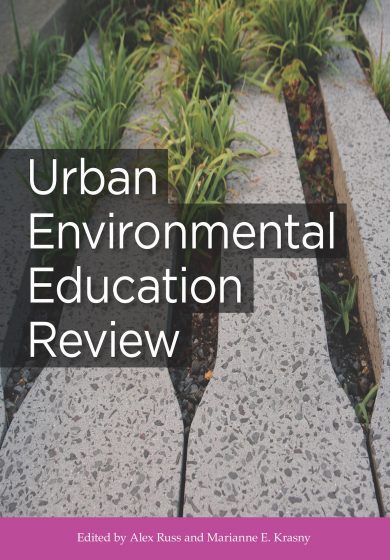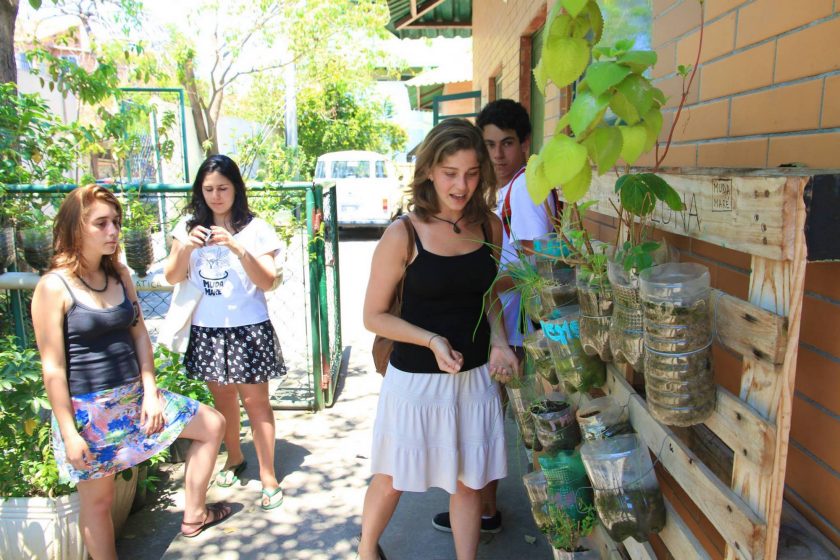Can environmental education in cities foster urban sustainability? Yes—according to 90 scholars from six continents who contributed to a forthcoming book called Urban Environmental Education Review (Russ and Krasny, eds, 2017). Three themes—participation of urban residents in planning and environmental stewardship, exploring and reconstructing urban places, and forming partnerships among disciplines and organizations who care about the urban environment—emerged from the book chapters as critical to environmental education’s ability to promote sustainability, justice, livability, and resilience in cities.
Urban environmental education is driving progress in the wider field of environmental education by emphasizing participation, place, and partnership.
Although urban environmental education seems like a relatively new field, environmental education and related conservation education turned attention to cities a long time ago. For example, in 1942, Renner noted, “It is often assumed that the city is a much poorer place in which to teach conservation than in the country community. It is doubtful, however, whether the city actually is a less fertile field than the country” (p. 194). He argued that cities offer opportunities to connect with nature through learning about conservation in city parks and restoring urban riverbanks. In an earlier book about conservation education, Renner and Hartley (1940) suggested that children spend too much time in movies while only occasionally in parks and that children can participate in urban planning. Later, Swan (1969) provided one of the first definitions of urban environmental education, emphasizing its importance in students developing awareness of urban settings and improving their schoolyards. This early writing about environmental education in cities predated the formalization of the broader field of environmental education in the 1970s.
Fast forward to today: environmental education is not the only field that helps urban residents learn about sustainability. Urban planners, artists, celebrities, science educators, and community leaders, alongside government agencies and businesses, all help urban residents address urban sustainability issues. Further, urban environmental educational activities are no longer confined to classrooms, parks, or far-away residential camps—in fact, they take place in most urban settings, including community gardens, water-treatment plants, schoolyards, green buildings, and urban restoration sites. And instead of a narrow focus on individual pro-environmental behaviors, urban environmental educators seek to change social norms, foster environmental citizenship, and help people re-think how we should organize cities for sustainability outcomes. These recent developments justify and bring new meaning to the term “urban environmental education,” which emphasizes a diversity of pedagogical methods, settings, providers, audiences, and goals.
To bring these assorted goals, practices, and professionals together, and to provide a theoretical lens and empirical research to support their work, we decided to produce a textbook on urban environmental education. How has Urban Environmental Education Review moved the field of environmental education forward? In addition to the myriad practices described by the authors, we discuss three principles of urban environmental education that emerged from the chapters in the book: participation, place, and partnership.

Participation
Danish scholars Jeppe Laessoe and O.K. Pedersen identified four types of participatory practices in environmental education: participation as encounters with nature, as action, as social learning, and as deliberative dialogue (Læssøe and Krasny, 2013). These practices are often combined in real life. Children in Boulder, Colorado, spend time observing insects in city parks (encounters with nature), and help redesign Boulder’s public spaces (action). Action approaches range from the political to urban planning, such as when impoverished youth in the highlands above La Paz advocated for an aerial tramway that would give them access to the city. In Australia, South Africa, and parts of Europe, where environmental educators assume a more deliberative and critical stance, social learning is intended to radically disrupt unsustainable routines and vested powers and interests.
However, participation is not without its challenges. For example, when rising sea levels immediately threaten a city, government regulations, social marketing, and other more government-directed approaches may be necessary. Participatory approaches can also be critiqued for their tokenism, and for claims that youth are the principal decision makers when in fact adult guidance is needed and prominent behind the scenes.

Place
Students who steward community gardens, plan for public transportation, or otherwise help address urban sustainability issues are reconstructing urban places. In so doing, they may be forming new place meanings, as we found among youth engaged in civic ecology practice in the Bronx, New York City (Kudryavtsev, Krasny and Stedman, 2013). For these youth, spending time creating a bioswale garden along the Bronx River or removing invasive species from an urban garden led to redefining their local place meanings. They no longer saw the Bronx as devoid of nature, but instead as a place where one could experience nature and wildlife. Whether changing place meanings through reconstructing places in turn helps address other sustainability remains to be seen.

Partnerships
Partnerships in urban environmental education cross disciplines, ethnic and cultural divides, and organizations or governance actors. All three types of partnerships are needed to address wicked problems.
At the Urban Ecology Center in Milwaukee Wisconsin, a green building, a solar power station, public art, an urban wasteland being transformed into a park, riparian habitats, classrooms, and a climbing wall string together disciplines such as civil engineering, landscape architecture, and building design, alongside education. Restoration-based education in cities means heeding local values, traditions, and socioeconomic conditions alongside ecological considerations, as well being sensitive to diverse cultures and issues of power. If one fails to incorporate such diversity, misinterpretations, failure, and even environmental injustices can result. Organizational partnerships may start as more narrow efforts to bridge formal and non-formal educational institutions, but then expand to actors not directly engaged in education. One example comes from Singapore’s cross-sectoral 3-P (People, Public and Private) partnership, which focuses on recycling, energy, and water conservation in schools, and engages a network of advisors from government, NGOs, and the private sector. An author from South America sums up how critical partnerships are, saying: “Over the last two decades, Brazil has come to the realization that the current state of the environment is too dire for environmental education to be carried out as individual initiatives.”
Environmental education has often been seen as promoting environmental literacy, which encompasses knowledge, affect, and action that benefit the individual and the environment. In cities, this means partnering with organizations addressing public health, justice and equity, community and youth development, and urban planning, among others. In short, environmental education can be one actor among many in addressing sustainability issues.

Cities as leaders in environmental education
Just as cities serve as centers for sustainability and resilience innovations, environmental education in cities has the potential to push the field of environmental education toward innovative practices, including practices related to diversity. Whereas environmental educators often talk about ethnic and other types of diversity, our reasons—“why diversity?”—may not always be clear (e.g., diversity initiatives that seek to help marginalized peoples, to address past injustices, or to engage multiple perspectives in order to generate sustainability innovations).
Drawing on ideas from social networking and social innovation, authors included in our Urban Environmental Education Review demonstrate how professionals trained in the environmental and education disciplines have as much to learn from those trained in community and youth development as practitioners in those fields have to learn about the environment. These two types of expertise come together in an after-school program at a Catholic charity in the Bronx, or a family empowerment initiative in public housing in Anacostia. Such urban programs engage youth and families in outdoor activities, but their primary goal is to foster youth communication and academic skills and strengthen family ties, rather than foster environmentally responsible behaviors. Although the urban, low-income audiences for these efforts suggest a diversity goal of helping marginalized people, the programs also reveal a change in perspective about diversity, from expanding existing outreach programs to simply being more inclusive of non-traditional audiences, to recognizing and honoring each professional actor’s assets—what each brings to the table—and how, by bringing different actors together, social innovations linking the environment, learning, and youth and community development can emerge.
Perhaps most importantly, by exploring the diverse practices and diverse forms of participation, place-making, and partnerships in cities, the authors help to move the broader field of environmental education forward. For years, our discipline has been defined—and sometimes constrained—by a definition generated at a UN convention in Tbilisi, USSR in 1977: “Environmental education is a learning process that increases people’s knowledge and awareness about the environment and its associated challenges, develops the necessary skills and expertise to address the challenges, and fosters attitudes, motivations, and commitments to make informed decisions and take responsible action.” Perhaps inadvertently, this definition implied that if we could teach people knowledge and increase their awareness, they would change their behaviors—an assumption that the years since Tbilisi have critically called into question.
Further, environmental education’s historical focus on individual behaviors has been challenged as the necessity for collective action becomes increasingly evident. Today, the North American Association of Environmental Education definition of environmental education incorporates civic engagement—perhaps reflecting research on social capital and collective efficacy that implies the importance of civic ties and local initiative in generating collective action. Urban environmental education—through forming partnerships with youth development and health and planning professionals, through incorporating notions of governance and social innovation, and through demonstrating how learning can be embedded in collective stewardship, restoration, and planning practice rather than as a precursor to environmental behaviors—is playing an important role in transforming the way we think about the relationships between environmental education, learning, and action.
To explore these ideas in-depth, we invite you to read the forthcoming 30-chapter edited book Urban Environmental Education Review. Also, watch 30 free videos recorded by chapter authors (see link below). Finally, the Cornell University Civic Ecology Lab plans to offer an Urban Environmental Education online courses in summer 2017.
Alex Russ and Marianne Krasny
Ithaca
Links
- For more about the book: http://cornellpress.cornell.edu/book/?GCOI=80140100988800
- Like the book’s Facebook group: https://www.facebook.com/ueebook
- Read ten free pre-edited chapters: https://www.thenatureofcities.com/urban-environmental-education-review/#TOC
- View 30 short lectures based on book chapters: https://www.youtube.com/playlist?list=PL4LUX34gvz9NdWaCqg6TxKBFP_2spWx3t
- Watch for announcements of the online course and book at www.civicecology.org
References
Kudryavtsev, A., Krasny, M. E., & Stedman, R. C. (2012). The impact of environmental education on sense of place among urban youth. Ecosphere, 3(4), 29. doi:10.1890/ES11-00318.1
Læssøe, J., and Krasny, M. E. (2013). Participation in environmental education: Crossing boundaries within the big tent. In M. E. Krasny and J. Dillon (Eds.), Trading zones in environmental education: Creating transdisciplinary dialogue (pp. 11–44). New York: Peter Lang.
Renner, G.T. (1942). Conservation of natural resources: An educational approach to the problem. New York: John Wiley and Sons.
Russ, A., and Krasny, M.E. (Eds.) (2017). Urban environmental education review. Ithaca, New York: Cornell University Press.
Swan, J. (1969). The challenge of environmental education. Phi Delta Kappan, 51(1), 26-28.
about the writer
Marianne Krasny
Marianne Krasny is professor in the Department of Natural Resources, Director of the Civic Ecology Lab at Cornell University, and a contributor to Forbes News.







Leave a Reply